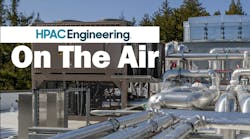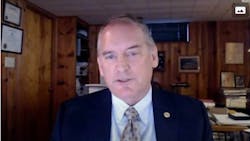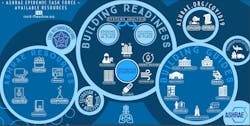HPAC 'On The Air': Inside the Epidemic Task Force, with Dr. Bill Bahnfleth
This month, HPAC 'On The Air' welcomes Dr. William P. Bahnfleth, P.E., an ASHRAE past president (2013-14), chair of the group's ongoing Epidemic Task Force, a professor of architectural engineering at Penn State University, and a longtime member of HPAC Engineering's Editorial Advisory Board.
Bill's father, Donald R. Bahnfleth, P.E. (1927-2016), also served as ASHRAE president in 1985-86, making them the only father and son duo to both hold that office in the 126-year history of the organization. In 2019, Bill even received the Donald Bahnfleth Environmental Health Award, which only that year had been renamed to honor his father's pioneering focus on indoor environmental quality (IEQ). Of note, from 1960 to 1971, the elder Bahnfleth also served as editorial director for HPAC Engineering, then known as Heating/Piping/Air Conditioning magazine.
For his part, Bill holds B.S., M.S. and Ph.D. degrees in mechanical engineering from the University of Illinois, and is a fellow at ASHRAE, the American Society of Mechanical Engineers (ASME), and the International Society for Indoor Air Quality and Climate (ISIAQC).
Early last year, however, Bahnfleth embarked on what he says may be "the most meaningful chapter" of his distinguished professional life when he was asked to assemble and lead an ASHRAE Epidemic Task Force to address the fast-growing public health emergency posed by the new Coronavirus global pandemic. Here, he offers a behind-the-scenes look at the last 18 months of urgent collaboration, research, recommendations, revisions, and now hope for a post-pandemic "paradigm shift" in managing and improving indoor air quality. To listen to our full show, click below...
For more from Dr. Bahnfleth, follow his lively Twitter feed at @WBahnfleth.
For the latest from ASHRAE's Epidemic Task Force, visit its interactive dashboard here.
What follows is a partial, edited transcript of this show:
HPAC: Bill, thanks so much for joining us. Let's dive right into the ASHRAE Epidemic Task Force (ETF) and go back to early 2020, when the depths of the looming pandemic was just becoming a reality. Please tell us how the ETF came into being, how you became its chair, and how its structure evolved...
Dr. Bahnfleth: Good to be with you, Rob. Looking back, our awareness of the pandemic developed very rapidly. The index case in China was in December of 2019, and we were only aware of it to a small extent at the ASHRAE Winter Meeting in Orlando at the end of January. Some exhibitors didn't show and there was concern that this was going to grow. But between then and late February, early March, it got into the U.S., and really took off. So, by then, it was clear that this was going to be a big issue here and for the rest of the world.
At that point, ASHRAE leadership approached the Environmental Health Committee and asked if there should be an ASHRAE group working specifically on pandemic response and what that should look like. Ultimately, I was invited to chair this group and even to name it. And they asked me to propose what we would do, and how we would do it. So it was really an unparalleled opportunity in my career as a volunteer or even a professional, to just start with a clean sheet of paper to try to solve a problem.
The one thing that was clear was that we needed to respond quickly. And most people know that speed is not really what ASHRAE is known for. It does high quality work, but that takes time. So, we were really being asked to cut against the grain of that typical ASHRAE process. I decided that what we would do was make a small group, but with a lot of leverage. So, instead of getting 15 or 20 people together and saying that we are going to write all of this guidance, I put together a group of subject matter experts in areas that I thought were going to be important, like air filtration, disinfection, and commissioning. And I said to those people to go out and find whoever you need to make a team that you will lead, and then produce guidance in that area. So we would function, more or less, as a steering committee. So that initial group of 15 to 20 people actually wound up working with over 130 subject matter experts.
One of the other things that I think was important was that while we were free to operate as an ad hoc group put together with the authority of the ASHRAE board, they insisted that we reach out to the rest of the Society and work with technical committees, and standing committees, and whoever else was necessary. So that was how it was structured and operated from the very beginning, and we would meet for about two hours every two weeks. So we have had more than 25 meetings now.
Our scope, first of all, was to develop guidance quickly, then to refine the guidance, and third, to make recommendations for the future about what ASHRAE needed to do after the Epidemic Task Force went away. So that we would be better prepared to respond the next time something like this happened.
HPAC: Nearly a year and a half later, after so much research, discussion, debate, consensus, recommendations, revisions and now several hundreds of pages of guidance, can you please sum up the ETF's latest core recommendations for our HVAC audience?
Dr. Bahnfleth: Over the course of 2020, from the time that we initially started issuing guidance, we started rethinking our approach to make it more flexible, and to dial back some earlier recommendations that clearly didn't seem to be necessary anymore. So that we had a package that could be used to suit the needs of a particular building. They are not perfect, but I still think it is a pretty good guide, given what we know and the time we had to produce it.
What do they say? Well, the first thing is to follow public health guidance. This goes along with the Swiss cheese approach to risk management. We can't rely on any one type of control, like HVAC, to remove risk to the maximum amount. So there is a layering of things like masking and social distancing, and now vaccinations. Regarding things like ventilation, there has been a lot of discussion about how much uncontaminated air is needed to reduce risk to an acceptable level. We have not published a hard recommendation on that, but we do say that buildings should at least have their code minimum of outdoor air as a starting point. That doesn't necessarily mean that's enough protection, but you shouldn't go under what the code requires. And that's important because a lot buildings are not actually up to code.
We also recommend not enabling demand-controlled ventilation during the pandemic because that reduces the amount of outdoor air in proportion to population, and that clearly is something that could increase risk. So for the time being, we recommend not doing that. Operating the system when people are present is important. Initially we had said 24/7, but the risk analysis has shown that that's not really necessary. Also, add filtration up to MERV 13, if you can do it. If not, then some other combination of controls that will get you there.
We encourage the use of air cleaners, but only air cleaners that are well-characterized in terms of their effectiveness and safety. Of course, that could be a long discussion, in itself. But basically at this point, the one that ASHRAE is very comfortable with is germicidal ultraviolet air disinfection. But other technologies may be used. There is still a lot of work going on right now looking at efficacy and safety. Also, for the present, portable or stand-alone air cleaners do seem to be a good approach when it's hard tp modify central systems.
The final recommendation is to commission buildings because we know that so many are not functioning up to their design intent. So that makes them unreliable and means they're probably wasting energy in addition to not providing good indoor air quality.
In May, you co-authored an article in Science magazine with 39 other scientists, IAQ experts and engineers, titled "A Paradigm Shift to Combat Indoor Respiratory Infections." You were hopeful that it could spur designers to become more proactive in creating healthier building environments, moving forward. But there has been pushback from some practicing engineers (see p. 20) who argue that taking on such roles will expose them to new liability and future lawsuits. Can you please explain this hopeful 'paradigm shift' a bit and why you believe those concerns are misplaced?
Dr. Bahnfleth: I actually have felt this way about indoor air quality for years. But two things have happened during the pandemic. One is that a lot of effort has gone into understanding how respiratory diseases are transmitted -- coronaviruses like SARS and MERS, COVID-19, and seasonal influenza. And I think there is a pretty strong case now that inhalation of aerosols is a big part of that. So that makes disease transmission partly a matter of exposure to air contaminants that we know how to control.
Buildings have an important role to play in mitigating diseases, and not just the kind that come around every 100 years or so, like the 1918 epidemic, and the current one. Seasonal influenza comes around every year and costs billions of dollars in healthcare costs and contributes to excess mortality. So the article views this as a tractable problem, one that we can do something about to reduce risk. The fact is that if you pick up a ventilation or indoor air quality standard like ASHRAE 62.1 or 62.2, you find that the definition of what's acceptable does not address communicable diseases or airborne infections. It deals with the kinds of contaminants that are associated with building emissions and outdoor air, and with bio-effluent from people. But it is silent on the issue of infection risk reduction. And we know that comparing those standards for non-healthcare buildings with the ones we use for healthcare buildings that the levels of ventilation and filtration that we have in most buildings are just not adequate for significant risk mitigation.
The "paradigm shift" is to bring some of that thinking into the development of new minimum standards for non-healthcare facilities. And I think that is a fairly straight-forward task.
So I think this argument about exposing professionals to additional liability is a bit of a red herring. I had been hearing that argument long before COVID-19, that any attempts to address health concerns will open professionals up to greater liability. But I think that is misstating what we are trying to do. We now have a large and growing body of work to help us improve indoor air quality. We are not saying that indoor air can make you healthy. But we know that if we don't treat it right, it can make you sick. So it's really just trying to raise the bar on what our expectations should be.
##########
For much more, please listen to the full podcast.
##########
To listen to previous 'HPAC On The Air' podcasts, visit our Members Only page.
##########
About the Author
Rob McManamy
Editor in Chief
An industry reporter and editor since 1987, McManamy joined HPAC Engineering in September 2017, after three years with BuiltWorlds.com, a Chicago-based media startup focused on tech innovation in the built environment. He has been covering design and construction issues for more than 30 years, having started at Engineering News-Record (ENR) in New York, before becoming its Midwest Bureau Chief in 1990. In 1998, McManamy was named Editor-in-Chief of Design-Build magazine, where he served for four years. He subsequently worked as an editor and freelance writer for Building Design + Construction and Public Works magazines.
A native of Bronx, NY, he is a graduate of both the University of Virginia, and The John Marshall Law School in Chicago.
Contact him at [email protected].


